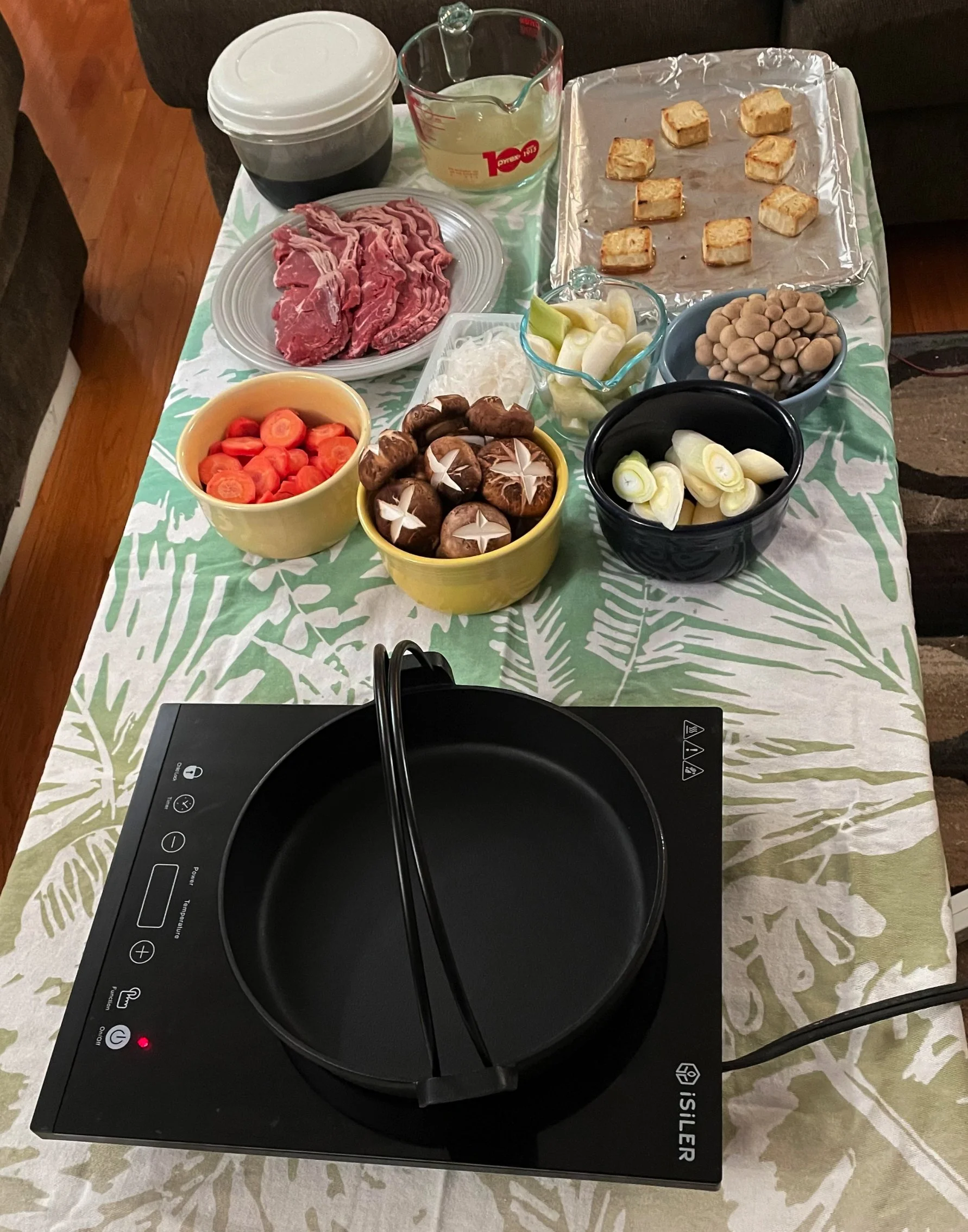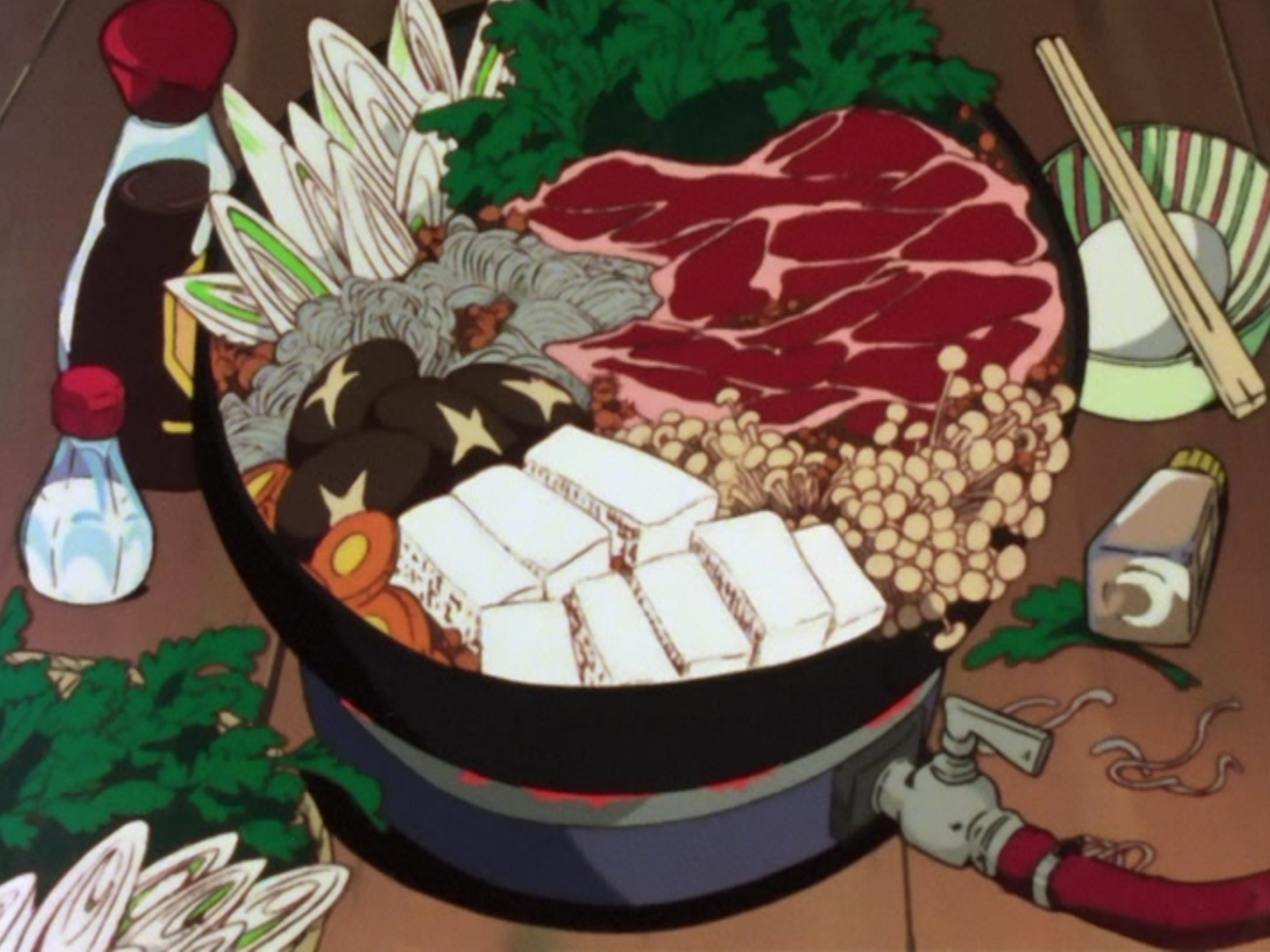Food Worth Fighting Over: How to make "Sukiyaki Hotpot"
How to Make Sukiyaki
Part 2 Episode 145, “Wings of Death: Albatross,” one of the best known episodes of Lupin III because it was directed by Hayao Miyazaki (and was also one of the first ones dubbed in English and brought to the United States thanks to that!) starts with Lupin, Jigen, and Goemon camping out in a little trailer and sharing a hot pot meal. This is referenced later in the second episode of Part 5, “The Lupin Game.”
“Hotpot” is a general term that spans many cultures, heavily in Asia, with everyone sharing a big bowl of broth in the middle of the table, cooking various proteins and veggies in it. The primary differences, outside of the cultural influences, are what the broth is made with. Sukiyaki has an umami broth with a mild (not spicy), sweet flavor that very much brings out the richness of the various things in it.
Sukiyaki was developed during the Meiji era (1868–1912), with a blend of cultures contributing to the various ingredients and broth that makes it what it is. It is usually cooked with beef, but occasionally you’ll find pork used, and from personal experience, the broth is rich enough that a vegetarian version would probably taste amazing!
Traditionally served in a nabemono — a deep cast iron pan with no handle — sukiyaki can be made in almost any pot that can handle being put on a burner, ranging from a regular cast iron pan to a dutch oven to a fondue pot, or even a crockpot!
This recipe will be for a relatively close recreation of the sukiyaki the boys were fighting over (and probably spilled a fair amount of due to Fujiko running through) in “Wings of Death: Albatross.” Many of these ingredients can be found at your local Asian market, but substitutions and how-to’s will be provided when they can be :)
“Eat the Tofu, You Jerks!” Sukiyaki
Broth
1 cup soy sauce
1 cup mirin
1 cup sake (can substitute dashi, vegetable broth, or water)
1/4 cup sugar
Mix all ingredients in small pot on medium heat, stirring occasionally so the sugar does not burn to the bottom of the pot, until the broth comes to a boil. Can be used immediately or stored in the fridge for up to a month!
Jigen adds beer instead of dashi, though we aren’t doing that in this particular recipe.
Ingredients
• 1-2 Tokyo negi onions
This ingredient is often difficult to find, even in Asian markets; you can substitute scallions or smaller leeks
• 4-6 Shiitake mushrooms
You can substitute cremini mushrooms; using fresh mushrooms is recommended
• 1 bunch Enoki mushrooms or Beech mushrooms
• 1 Carrot, peeled & cut into 1/4 wide slices
• 1 packet Shirataki/yam noodles
You can substitute rice noodles or vermicelli
Interesting to note: Shirataki noodles are made from the same kind of yam that Zantetsuken cannot cut, konjac!
• 1 bunch Garland Chrysanthemum
Can substitute other greens such as mizuna, Napa cabbage, or spinach
• 1-2 cups Dashi
Dashi is a Japanese soup stock, and can be seafood or vegetable/seaweed based. You can find powder packets for making it online or at an Asian market, but you can also substitute vegetable broth or water
• 1 block Extra Firm Tofu
Broiled tofu, called “Yaki tofu,” can often be found in Asian markets and is recommended here.
• 1 pound Thinly Sliced Beef
So much of sukiyaki is setup! Always be sure to wash your produce before you start cutting it.
Slicing the Negi Onions/Scallions/Leeks:
Note: If you use leeks, make sure they have been well-washed! Leeks often get sand or other grit between their layers. I recommend rinsing the leeks both before and after you slice to prevent any crunchy bits from getting into your sukiyaki.
Cut the onions diagonally to get the most broth coverage!
The boys used especially large chunks of onion in their hotpot; I personally recommend slicing them a bit thinner, to get more coverage from the broth.
Slicing Stars Into Your Mushrooms:
It seems super fancy but it’s quite simple to do!
How To Broil Tofu:
If you cannot find yaki tofu in your local Asian market but would still like to add broiled tofu to your hotpot, you can broil tofu at home!
Get a block of extra firm tofu. Wrap the tofu in paper towels and set on a flat plate or cutting board — using something with sides will be extremely beneficial to you here, because you are going to be squishing all the excess moisture out of the block. Set another flat plate, or pan, or something that can be washed, on top of the tofu. Add something heavy — thick books are a good example — on top of that second plate. Now let the tofu sit for 30 minutes.
Unwrap! You should have squished a fair amount of liquid out of the block.
To broil it, you have multiple options: If your oven or toaster oven has a “Broil” option, you can use it here, keeping the pan close to the broil feature and flipping the block after 3-5 minutes to get both sides (keep an eye on it; broilers are extremely variable between ovens!). You can also use a kitchen torch, like you’d use for creme brulee!
(Do NOT use a lighter.)
How To Thinly Slice Beef:
If you can’t find thin-sliced beef at your Asian market, and your local grocery butcher won’t do it, you can do that at home, too, but it requires a little more patience. For sukiyaki, you’ll want a cut of meat like top sirloin or ribeye. Be sure to get boneless cuts unless you don’t mind more work!
Stick your cut(s) of meat in a plastic bag, squishing all the air out, and place on a metal pan (this will help with the temperature regulation) and stick it in your freezer. Depending on the cut of meat, it should take 1-2 hours to freeze to a good temperature for cutting; the meat will be very firm. If it’s squishy and the knife wants to wobble away when you try slicing through it, it’s not frozen enough. If your knife can’t go through at all, it’s too frozen.
Sukiyaki cuts are a bit thicker than shabu shabu or other styles of hotpot, but they are still very thin (1.5-3mm, or around a tenth of an inch at thickest). If you have a mandolin slicer, you can use it here! It will be very helpful, even moreso if it’s metal and you also stick it in the freezer along with the meat. Otherwise, the cuts are going to depend on a steady hand, and extremely sharp knife, and possibly a ruler. Good luck, and be safe!
We used an induction cooktop instead of a camp stove, but they didn’t have those when this episode came out.
How To Put It All Together:
Mix half your sukiyaki broth and half of the dashi in the pot you’ll be serving in. Layer in the meat, veggies, and other goodies, and then bring the mix to a low boil. Unlike a lot of varieties of hotpot, sukiyaki starts with the main dipping ingredients all in the same pot, a bit like a casserole, and you add others as the first batch gets eaten.
Assuming your trailer doesn’t end up exploding and a nuclear weapon doesn’t get dropped in your soup, sukiyaki can be finished by adding cooked udon noodles to soak up the last of the broth! It also keeps very well for leftovers.
This recipe is rebuilding the hotpot we see in the episode, but as a general note: Sukiyaki, like many soups and hotpots, is extremely variable! Please feel free to experiment and indulge the flavors you enjoy!
Credits: Wikipedia, Just One Cookbook, and Tabbie’s partner for helping her with the food prep :)
















